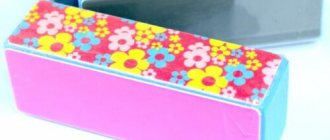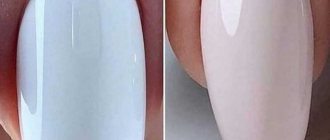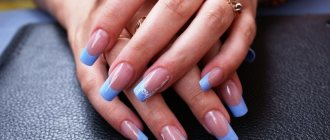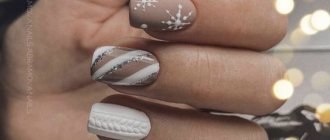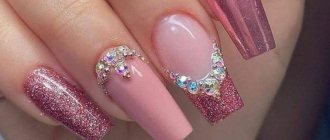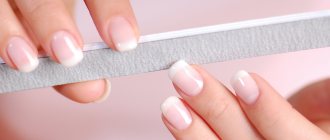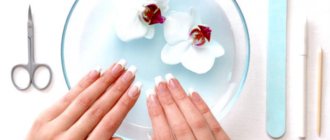A nail file is an indispensable manicure tool for every girl, and not just for a manicurist. It performs several functions at once: with a file you can remove the length of the nail plate, shape your nails, polish them to a shine, and lift the nail scales to improve adhesion between the artificial coating and the nail.
But when choosing such a simple, at first glance, tool, several questions arise at once:
- What material is better to choose a nail file from?
- What is abrasiveness and grit? What are they talking about?
- file shape. What is it for and which one is it intended for?
Well, let's find out.
Types of files by material
The first thing we encounter when choosing a nail file is the material from which it is made.
Disposable files
These nail files are made of polystyrene foam or multi-layer cardboard. The top is covered with tiny Teflon, quartz or granite chips. Disposable files are an ideal option for manicurists and beauty salons. From the name it becomes clear that they can only be used once. As a last resort, you can have a separate nail file for each client. Such files cannot be washed or sterilized; they deteriorate from moisture and high temperatures. But they are low cost, so one-time use is quite justified.
Set of classic nail files gray 100/180 g ParisNail 10 pcs/pack
Buff mini 100/180 white ParisNail 50 pcs
Set of nail files pink boat 100/180 g ParisNail 10 pcs/pack
Metal files
Reliable, versatile, durable. These files can be used for several years. Due to their low cost and long service life, this type of file has not lost popularity for several decades. However, experts do not recommend using them on the natural nail plate, especially if it is peeling and brittle. This can cause your nails to split even more. What are metal files used for? For working with thick nails in pedicure, as well as for correcting the shape and length of extended nails.
Glass files
Glass files allow you to carefully and accurately remove the length of the nail plate, give it the desired shape and not be afraid that your nails will begin to peel in the future. They are absolutely safe for natural nails. Glass files are resistant to high temperatures, so they can be sterilized in dry heat. When using, be careful not to drop this nail file, otherwise it may break.
Bohemia glass file, color 1202b, length 12 cm Solinberg
Bohemia glass file, colored 0902b, length 9 cm Solinberg
Ceramic files
Ideal for thin, brittle and peeling nail plates. These files are quite soft and do not allow natural nails to peel. They so neatly align the free edge of the nail plate that they even began to be called “healing”. This type of file is also suitable for treating the skin around the nails. But they are unlikely to be able to correct the shape of extended nails.
Files on a wooden base
Files on a wooden base are intended for pedicure. The base is rigid, so the files do not bend. At the same time, they are lightweight and very convenient to use. The abrasive is held in place by glue. Such files can be disinfected, so they can be used for individual use many times.
Medium wooden pedicure grater AT-251 Silver Star
Wooden grater for pedicure PF-932-W METZGER
Foot grater SFP 009 YOKO
Laser files
Laser files are a new product in the nail industry, which confidently occupies a leading position. These files are made of plastic or metal. Holes are made on them in the form of a diamond-coated pattern, which is applied with a laser. Laser files perfectly “seal” the edges of the nail plate, thereby preventing it from delaminating.
Laser file 445 Solinberg
Laser file 14.8 cm Planet Nails
Laser file 443 Solinberg
Filing gel polish off extended nails
In this case, solvents with acetone are definitely not suitable. If you use any other product that does not contain acetone, the coating will not come off. You can use a nail file. But the best option would still be to use a manicure cutter. It is desirable that the cutter coating be ceramic. But since the cost of such a product will be quite high, you can choose a carbide analogue.
It must be borne in mind that there are several forms of this tool: cone-shaped, cylindrical, etc. As for the rotation speed, it should not be less than a thousand revolutions.
The sequence of actions is as follows:
- First, move the cuticle, then turn on the desktop vacuum cleaner.
- The cutter should be guided from the cuticle to the edge of the nail. The direction must be the same. In addition, it is necessary to move the tool as it rotates.
- Do not press on the nail plate, otherwise it will damage it. If an unpleasant burning sensation occurs, the speed of the router should be increased. This will reduce the pressure on the nail.
As soon as the gel polish is completely removed, it is necessary to correct the nails. There should also be no fear in sawing through the plate. We must understand. That gel polish is a fairly dense coating. As a rule, it reliably protects the nail from damage. However, if a crack has formed in the coating, this can be corrected with a simple nail file. In this case, it is best to use a tool whose abrasiveness is 100–180 grit. For polishing, multi-grain files are used - from 900 to 1200 grit.
How to properly file gel from nails using a nail file?
- The file must be moved from the cuticle to the very edge of the nail.
- The direction must be the same. In addition, every movement should be smooth.
- If you want to apply a new coating immediately, then there is no point in removing the base.
- At the end of the work, dust should be wiped off the nail plates.
- Then the nails are polished using a buff.
- Only after this a new coating is applied.
Abrasiveness of nail files
In other words, abrasiveness is the hardness of the files, which is measured in grits. The more you grit, the softer the file; the less you grit, the harder it is. This indicator is usually indicated on the surface of the file or on the packaging. Quite often there are saw blades with two numbers, for example, 240/180. This means that one side of the file is softer and the other is harder.
Abrasiveness of artificial nail files
80-150 grit – hard files for artificial nails. These files are ONLY suitable for working on artificial nails. They can easily handle gel, acrylic, and tips. It is not recommended to use hard files on the natural nail plate.
Abrasiveness of files for extended and natural nails
150-240 grit – files of medium hardness. These files are suitable for both shaping and processing the length of the natural nail plate, and for processing extended nails.
Abrasiveness of files for preparing the nail plate
240-800 grit – buffs and polishers. Used to prepare the nail plate for artificial coating or nail extensions. They gently lift the scales of the nail plate, thereby improving the adhesion between the nail and the artificial material. They also allow you to remove gloss and unevenness of the nail plate.
Abrasiveness of nail polishing files
900-3000 grit – polishers. Polishers give nails a mirror shine. Mainly used for treating acrylic nails, but sometimes used for polishing natural nails.
Which manicure is better: edged or unedged?
Classic and European manicure have a common goal, but completely different characteristics. It is difficult to say which one is better; each has its own advantages and disadvantages, its opponents and admirers. Considering the technology of performing European manicure, we will dwell in more detail on its pros and cons.
Pros:
- Absolute safety of the procedure. Eliminating the risk of infection, including the hepatitis virus or immunodeficiency virus.
- Relevance for people with thin, fragile and brittle nails, as well as for those whose capillaries are too close.
- It is a proven fact that European manicure increases the durability of varnish by about 7 days. This is explained by the fact that when the nail bed is released, the cuticle is moved back so as not to damage it. The root of the nail has constant access to oxygen, it actively grows, and its internal structure is strengthened.
- Thanks to the use of remover, the condition of the skin and nails improves. Everyone knows how useful peeling is, helping to renew the skin and rid it of dead particles. The cuticle is also updated. The acids, vitamins, oils, and plant extracts included in the remover gently act on the skin around the nails, removing dead tissue. This has an extremely positive effect on the condition of the epidermis and the nails themselves.
- It is enough to carry out 8-10 procedures to notice a slowdown in cuticle growth. Correction is required much less frequently.
- The technology of performing European manicure allows you to save both money and time. High-quality tools for classic manicure are not cheap, but you don’t have to spend money on them. No other consumables will be required. Once you get the hang of it, it will take you about 20 minutes to perform a hygienic unedged manicure. And this is much faster than the classic procedure.
Minuses:
- The technology for performing European manicure does not provide for the treatment of the cuticle if it is dense, problematic and very dry. For girls whose nails are growing quickly, there is also no point in switching to an unedged manicure.
- Insufficient softening of the cuticle before treatment can cause the appearance of unwanted burrs that will have to be cut off with scissors.
- An unedged manicure is not suitable for undisciplined people, as it requires constant care of the cuticle. It must be systematically removed and treated with a special nutrient solution containing natural plant components.
- When transitioning from a classic to an unedged manicure, the varnish coating requires more frequent updating.
- You can improve the condition of your skin and nails only with high-quality and proven cuticle treatment products. Cheap formulations of unknown origin should be avoided so as not to worsen the condition of the nails.
The technology of performing European manicure is quite new and has its fans and admirers, as well as opponents. We recommend that you try it to see how effective it is and see if it's right for you.
Types of files according to shape
Files differ from each other not only in material and abrasiveness, but also in shape. Let's look at the main shapes of nail files that can be found in a store window.
Straight (rectangular) shape
It is considered a classic type of file. It is used to give shape and length to nails in both manicure and pedicure.
Nail file wide 240/240 TNL ind/pack
Nail file Square 100/180 Kodi
Arc (boomerang, banana)
Most masters prefer this particular form of files, since it is believed that it is most convenient for filing the free edge of the nail plate. This shape allows you to shape the nails without twisting the clients’ hands while working. It is also great for beginners.
Mylar nail file boomerang 80/80 red OPTION
Nail file boomerang zebra 100/180 Planet Nails
Nail file boomerang-wide 100/180 zebra OPTION
Buff (grinder)
Buffs can be in the shape of a rectangle or parallelepiped. Its main task is to prepare the surface of the nail plate for applying an artificial coating.
Buff mini 100/180 red ParisNail 50 pcs
Buff mini 100/180 Green Monami 50 pcs
Set of mini sanding blocks “Mosaic” 2-sided IRISK 9 pcs
Block shaped file
This file is also a parallelepiped. Each of its sides has a certain abrasiveness. It is convenient due to its multifunctionality: it can be processed, sanded, and then polished the nail plate. But masters use it in their work quite rarely. This file is more suitable for home use.
And a few more popular file shapes among craftsmen that cannot be ignored:
- oval shape;
- dome (boat);
- diamond shape.
Set of classic nail files gray 100/180 g ParisNail 10 pcs/pack
Set of nail files pink boat 180/200 gr ParisNail 50 pcs/pack
Nail file pink boat 180/180 gr ParisNail
Glass file
This option is often used for self-processing. It is used on natural nails not covered with gel polish or gel. This is a modern analogue of the metal and diamond files, which have long since lost their popularity.
The glass file eliminates the possibility of injury. The negative side is the need for fairly frequent changes. The spraying is erased and nail treatment becomes pointless.
Rules for filing nails
In order not to harm the nail plate and the skin around it, you must follow a few simple rules:
- Do not file your nails immediately after taking a bath or shower. Wait for the nail plate to dry!
- Work with the file in one direction from the edge of the nail to the center. Avoid movements in different directions, as well as sudden impact.
- Use personal instrument only. Do not lend it to friends or relatives to minimize the chance of infection.
- Now you understand the abrasiveness of nail files. Use the one that suits your specific case.
- Grind with buffs.
- Polish your nail plate no more than once a week.
- After treating your nails and skin, use a moisturizing or nourishing cream.
Note!
How to properly do a manicure and apply artificial nail polish at home is described in detail in the article “How to apply gel polish at home?”
The ability to understand the types of nail files is a necessary skill for every girl. And even more so for every master. And to learn even more manicure secrets and become a real professional, take manicure courses at ParisNail school.
How to determine the quality of a nail file?
Despite the variety of manicure tools, not all can be considered of sufficient quality. And hardly anyone will have the desire to use a bad nail file. Therefore, before you give money for a product, you should pay attention to several signs that will openly demonstrate the degree of its quality:
- The nail file should be flexible. In this case, it will not damage the nail, and will serve its owner for a long time.
- Between the frame and the surface that is intended for work, a special gasket is required.
- If the base of the nail file is made of plastic, then it will be the most reliable. The same cannot be said about a wooden frame.
How to save money on manicure?
Do you want to perfectly master the art of manicure from A to Z and never spend 2,000-3,000 rubles in a salon again? Then learn how to do a manicure yourself and save money, time and nerves!
Come to our School for an online course from top teacher Tatyana Svoboda “Manicure for yourself,” which can now be completed for only 499 rubles !
The teacher will tell you all about the technique of applying the coating, removing it, modern designs, how to strengthen your nails, and much more. You will become a real pro and will be able to create your dream nail designs, and, if you wish, monetize your hobby in the future!
Course bonuses:
We give all students a 15% discount on ready-made manicure starter kits, as well as a 5% discount on purchases at ParisNail and 15% on any other online course. Upon completion of the training, you will be issued an electronic certificate of completion of the course.
Types of European manicure
There are several varieties of European manicure:
- Hot.
This is a procedure that requires a thorough approach and gives a fairly long-lasting effect. A hot, unedged manicure is an excellent choice for advanced cases, when the cuticle has not only grown, but has already dried out and burst, forming painful cracks. It can be compared to relaxing spa treatments. You just need to fill the bath with any cream, light moisturizing essence or oil and warm it up a little. Immerse your hands in the warm mixture for at least 10 minutes. Then wipe your palms and fingers with a napkin, removing excess cream, and begin basic care. While taking a bath, the epidermis is saturated with moisture, the result becomes noticeable after the first time.
- Wet.
Some people are sure that its algorithm is similar to the hot technology of European manicure. This is a misconception. A wet manicure involves first applying a cuticle remover to problem areas and then immersing your fingers in a bath with a warm mixture of water, sea salt and a small amount of essential oils. After 10 minutes, they are dried with a towel and the cuticles are moved with gentle movements, resulting in neat, fresh nails.
- Dry.
This type is considered the fastest method of care, so it is often performed as an express service. The technology of performing European manicure using the dry method is ideal for people with slow-growing cuticles and strong nails. In this case, oils and baths are not needed to maintain a presentable appearance of your fingers. It is enough to soften the cuticle with a remover and push away the rollers with a metal pusher or an orange stick.
Sign up for eyelash extensions at Anna Klyuchko's studios with a 15% discount until March 7
12 studios throughout Moscow, St. Petersburg, Nizhny Novgorod and Tula
223 masters for every taste
High-quality service with a 7-day guarantee
Regular promotions and gifts for clients
Full volume 1990₽ 1692₽ Double volume 2590₽ 2202₽ Triple volume 2890₽ 2457₽ Hollywood volume 3400₽ 2890₽
Book 15% discount
Sanding and polishing
Polishing and buffing of nails is recommended only if they are not weak and brittle. Otherwise, their condition may worsen. After processing, it is necessary to cover the plate and the skin around it with cream or oil.
Perform polishing
To ensure that the surface of the nail plate is perfectly smooth and shiny, it must be polished. For this type of processing, a buff or a special polisher is used. Polishers are available in the form of bars or files with a suede or abrasive working base. The suede tool makes the surface smooth and shiny. Cream should be applied to it before the procedure. Oil must be applied before polishing with abrasive files. They, like suede ones, smooth the surface and give it shine. The file must be moved across the surface of the nail; you cannot make circular movements. Polishing is carried out a maximum of two to three times a month.
Polishing stages:
- Soft sanding. It is necessary to remove moisture, eliminate yellowish tints and unevenness. It is carried out using a file against the growth of the nail.
- Primary polishing. Smoothes scales, eliminates micro-scratches and unevenness. It is carried out with a stiffer polishing file in the direction of growth of the nail plate.
- Secondary polishing. It is made with a softer file for final leveling and giving a glossy shine to the plate.
- And at the end of the procedure, the nail is lubricated with a nourishing moisturizing cream or oil and rubbed into the surface.
You can polish your nails not only on your hands, but also on your feet. The polishing process for a pedicure is the same as for a manicure.
What is nail polishing
Nail polishing is a special procedure for treating the nail plate, after which the nail acquires a healthy, well-groomed appearance, a smooth surface and shine.
In addition, this procedure promotes rapid growth of nails. It is necessary to eliminate surface unevenness and helps with damage and dull shade of the plate. Polishing should be carried out no more than two or three times every month. It should be noted that this procedure is not recommended for brittle, fragile nails that are susceptible to lamination. In such a situation, it is initially necessary to bring the nail plate into a healthy appearance using strengthening agents and baths. You can also replace polishing weakened nails with wax. In this case, the polishing file can only be used when sealing the nails. An effective remedy for peeling nails using a soft polishing file is polishing with essential oils.
In general, it should be noted that experts do not recommend polishing even the strongest nails too often. Maximum once every 1-2 months.
